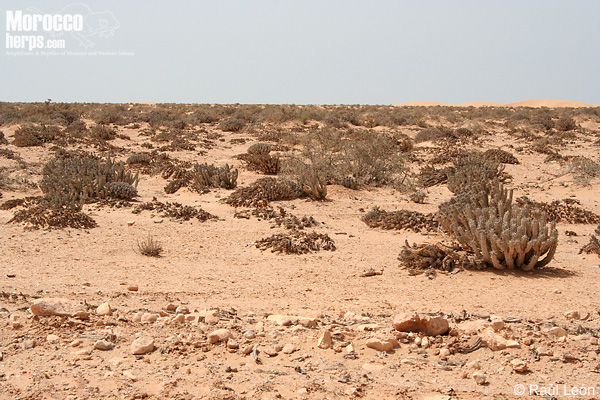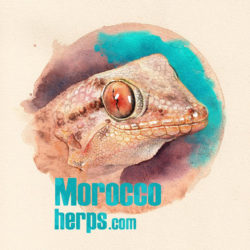African House Snake
Boaedon fuliginosus (Boie, 1827)
By Raúl León Vigara
Updated: 14/05/2020
Taxonomy: Serpentes | Lamprophiidae | Boaedon | Boaedon fuliginosus


 Boaedon fuliginosus
Boaedon fuliginosus
Distribution map of
Boaedon fuliginosus
in Morocco.
Gallery: 5 photos. [ENTER]
Phylogenetic frame
Formerly classified as Lamprophis fuliginosus. Kelly´s et al., investigations in 2011 indicate that Lamprophis fuliginosus is a complex of species including again the Boaedon, being this species classified as Boaedon fuliginosus. The genus Lamprophis is then formed by 4 species of South African snakes.
Description
Medium-sized snake from 60-120 cm (Schleich et al., 1996) with a maximum length of 150 cm (Hermann, 1989). The shape of its body is thinner at its sides.
It is a non-poisonous snake, with aglyphus teeth.
It is its bright, smooth and iridescent coloration what turns this snake into a beautiful animal. Juvenile specimens are normally solid/plain black while adults are dark brown or grayish-brown which white ventral coloration normally is observed from ventral scales to those, more evident, located on the neck or labial scales (both infralabials and supralabials). The ventral scales are of pearly-white coloration.

The head is long, narrow and somehow is compressed at the dorsoventral area. The eyes are relatively big, with the same coloration as the body and they have elliptical or vertical pupils.
Regarding the sexual dimorphism, Schleich stated that female specimens have higher number of ventral scales (209-249) than males (192-230). However, female have less caudal scales (42-59) than males (56-75). Due to the hemipenes, a protrusion at the base of the tail can be observed in adults.
Being plain dark, Boaedon fuliginosus could be, at a quick look, confused with adult specimens of the Egyptian Cobra (Naja haje). Some hints to differentiate these two specimens are: the size of scales are relatively bigger in the Egyptian Cobra than in the Brown House Snake, so scales on cobras are more noticeable and marked than on Brown House Snakes. Adult cobras are of a regular black color while Brown House Snakes are dark brown, grayish- brown even though they could also be black. However, we must note that both sub-adult and adult cobras could show up different colorations from dirty black, to dark brown or even brown mixed with black; this could lead again to confuse it with the Brown House Snake. Brown House Snakes are dark but always a very bright dark, while cobras are not as bright, more muted colored or “dirty” colored. So we can say that the scales on Brown House Snakes reflect more light and have a brighter aspect than the scales on the Egyptian cobra. Adult Brown House Snakes have white or pale labial scales as well as on the neck area, while this pattern is never observed on cobras. The ventral area of a cobra is black while in a Brown House Snake is pearly white. Boaedon fuliginosus and Naja haje have similar dark eyes, though the first has got relatively bigger eyes and elliptical pupils and Naja haje has got rounded pupils not easily perceived at first sight.

Both species have similar behavior of escaping when they feel threatened, however cobras may adopt their intimidating strategy by lifting and flattening the head and neck expanding the hood. Brown House Snakes do not show this passive-defense behavior.

There is not any similarity between juvenile Brown House Snakes and juvenile cobras. Juvenile Brown House Snakes are light black with a white ventral area and juvenile cobras are yellow with brown or black spots and just the head and the neck are black.

Ecology and habits
It stays under its shelter during the day and at night-time it starts searching its preys actively. It uses the constriction to paralyze its preys before eating them. They feed mainly on small mammals (mice, shrews, etc.) (Trape and Mané, 2006) but they also feed on other reptiles, amphibians and birds (Schleich et al., 1996). When they live nearby populated areas they should be highly-valued animals as they control rodent plagues (Schleich et al., 1996).
When they feel threatened they try to escape but if they are captured they try to bite to defend themselves. However, it is a harmless species.
Distribution, habitat and abundance
They are distributed from the coastal areas near Aoulouz and el Aaiún (Bons and Geniez, 1996). It is other example of tropical fauna, original from the South maintaining some specimens in the North West of Africa.
They live in arid areas near the Atlantic coast, flatlands with some bushes and Euphorbia, areas with dispersed trees and bushes, rocky areas, including habitats with no bushes at all.



It is considered a rare species in the research area. As proposed by Geniez and Bons, these reptiles coming from more tropical regions should be urgently protected.
The main causes of mortality could be hit by cars and when they get inside some infrastructures-as pits or water reservoirs- from where they cannot leave; dying from drowning or starvation. It is relevant the number of specimens killed by people as well as captured for the trafficking and selling.
Translated by Carlos Perez Fontán-Membrives.
References
- Bons, J. y Geniez, P. 1996. Anfibios y Reptiles de Marruecos (incluyendo Sáhara Occidental). Atlas Biogeográfico. Asociación Herpetológica Española. Barcelona. 319 pp
- Kelly, C.M.R.; William R. B., Donald G. B., Nigel P. B., Martin H. V. 2011. Molecular systematics of the African snake family Lamprophiidae Fitzinger, 1843 (Serpentes: Elapoidea), with particular focus on the genera Lamprophis Fitzinger 1843 and Mehelya Csiki 1903. Molecular Phylogenetic and Evolution. 58(3): 415-426
- Schleich, H. H., Kästle, W., Kabisch, K. 1996. Amphibians and Reptiles of North Africa. Koeltz Sci. Books, Koenigstein.
- Trape, J.F. y Mané, Y. 2006. Guide des serpents d’Afrique occidentale. Savane et désert. IRD Editions, Paris, 226 pp.
To cite this page:
Raúl León Vigara (2013): Boaedon fuliginosus (Boie, 1827). In: Martínez, G., León, R., Jiménez-Robles, O., González De la Vega, J. P., Gabari, V., Rebollo, B., Sánchez-Tójar, A., Fernández-Cardenete, J. R., Gállego, J. (Eds.). Moroccoherps. Amphibians and Reptiles of Morocco and Western Sahara.
Available from www.moroccoherps.com/en/ficha/Boaedon_fuliginosus/. Version 13/01/2013.
To cite www.morocoherps.com en as a whole:
Martínez, G., León, R., Jiménez-Robles, O., González De la Vega, J.P., Gabari, V., Rebollo, B., Sánchez-Tójar, A., Fernández-Cardenete, J.R., Gállego, J. (Eds.). Moroccoherps. Amphibians and Reptiles of Morocco and Western Sahara.
Available from www.moroccoherps.com.

